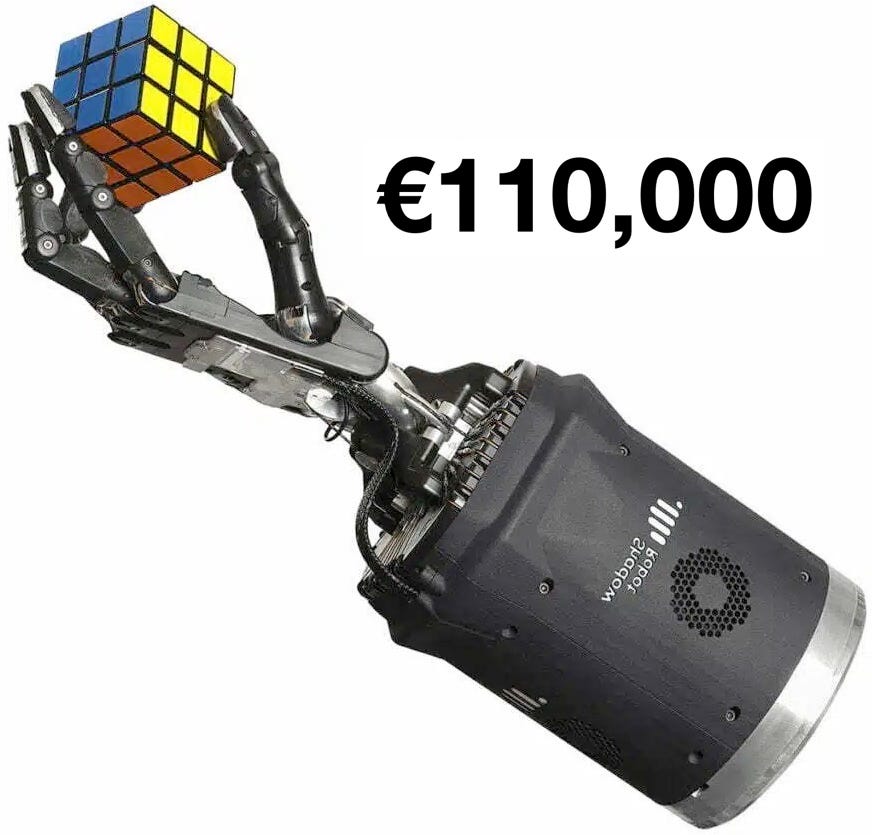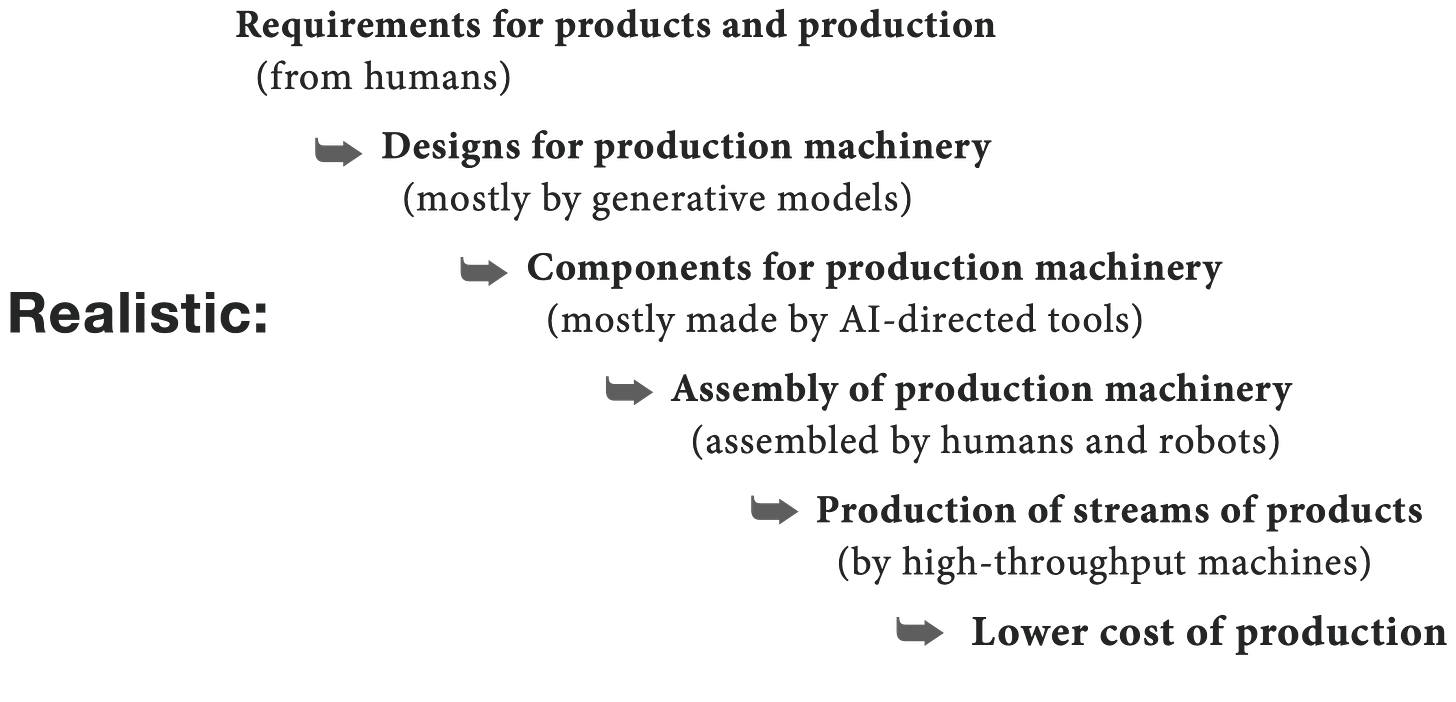Toward deep automation
AI and robotics will revolutionize production capacity and reduce costs, but machines making more machines doesn’t mean hordes of robots building more robots.
The material foundations of civilization rest on the production of physical things, but the infrastructure of manufacturing is almost invisible and unimaginably complex. AI will transform this hidden world, scaling production, dropping costs, and transforming possibilities (more products and cleaner production), but cartoonish views of humanoid robots simply replacing humans in factories undermine the credibility of deeply transformative advances. Let's consider a picture that aligns better with reality.1
The fundamentals: Eyes, brains, and hands
The human roles in production involve seeing, thinking, and using our hands to move things. The great breakthrough of the Industrial Revolution was the development of steam-driven machines that could move themselves. And this was a result of humans seeing, thinking, and making things by moving their hands.
Machines have now begun to see, think,2 and use ‘end effectors’ that are somewhat like hands. Early robots moved in repetitive ways, but today’s robots are increasingly able to follow instructions and perform novel tasks. If we think of humans doing work, and automation as replacing humans, then human-like robots may seem to be the way of the future. But does this really align with reality?
Humanoid robots aren’t for advanced manufacturing
A naïve concept of advanced automation pictures factories full of humanoid robots using their hands to build humanoid robots. This is easy to imagine, but it’s neither credible nor realistic: Humanoid robots are needlessly costly, clumsy, and slow.
Even a hand can be expensive: this one costs €110,000, which is roughly half its weight in gold.3
Industrial practicality would require enormous improvements in both cost and performance, yet what we see is the product of decades of work. Humanoid robots may have a role in human environments — where many tasks require eyes, hands, legs, and improvisation — but they’re a poor fit when tasks can be broken down into chains of repeated motions, performed millions of times in environments that can be designed together with the machines themselves.
Today’s factories are designed for humans, and humanoid robots are a retrofit for the residual human jobs — “residual” because most actions are already performed by simpler, less photogenic machines.
How real mass production works
In factories, machines that move things are seldom called ‘robots’ — they’re simpler, specialized, and often fast:
Chains of simple machines that execute complex sequences of motions can reduce costs and increase throughput.4 For example, consider a manufacturing task that requires 1000 motions: A machine that flows products through a chain of 1000 simple, single-motion devices can do the work of 1000 general-purpose robots working in parallel — or more than that, because single-motion devices often work faster by an order of magnitude or more. If a typical single-motion device costs 1/100th as much as a robot and works at 10 times the speed, then throughput per unit cost can be greater by a factor of 1000.
It’s easy to imagine a room full of humanoid robots, but it’s almost impossible to picture a machine that chains together 1000 different devices. This places realism — and credible expectations — at a memetic disadvantage.
Automating the process of automation
We’re now building robots that have something like hands, eyes, and brains, a development that points the way to automating tasks that call for human-like adaptability and problem solving — tasks like assembling unique parts to build specialized systems for high-throughput manufacturing. But automating these tasks is among the most challenging and least important aspects of automation: Their challenges are obvious, but their importance is low because the tasks aren’t frequent, not part of ongoing workflows.
It's possible to doubt the practicality of large-scale employment of human-level robotics while still expecting deep reductions in the labor required for building and operating manufacturing systems.
A key part of the story is automation of the process of automation: the crucial element isn't making products, it’s automating the design and construction of machines that make the products.
High-throughput production machinery may require many specialized single-motion machines, and designing those machines and making their components can be a costly bottleneck. Advanced AI will start to break this bottleneck when generative models take up the burden of machine design.5
CNC machine tools and 3D printing technologies can produce unique parts for unique machines with minimal labor, provided they’re programmed in detail — and automating their programming is usually straightforward, provided that the design fits what the tools can make, a constraint called “design for manufacturing”.6 The picture that emerges looks something like this:
Rather than centering on robots, this implementation work-flow centers on the design and manufacture of machines that are designed to fit available manufacturing processes: Machines can be designed to work in designed environments, making machines that are designed to be made by machines that were co-designed with their products. They key to this level of adaptation and integration is AI-enabled design capacity, not AI-controlled robots.7
The easy-to-imagine prospect, however, looks something like this:
This concept is simplistic, unrealistic, and only superficially credible, yet it does point toward a realistic endpoint.
“It’s a manufacturing problem”
Consider some ways in which these advances could contribute to global goal alignment:
Accelerating renewable energy
The costs of wind and solar energy are mostly costs of installed physical capital. Lower these costs, and the cost of renewables falls steeply. Employ high-throughput production methods, and deployment can be rapid. Installation can also be automated: Use step-and-place machinery to help install made-for-placement photovoltaics and use smart cranes to help assemble the parts of made-for-assembly wind turbines.
Reducing environmental impacts
Why aren’t production processes as clean as possible, or nearly so? The problem is cost — the added costs of pollution control equipment, the potentially higher costs of lower-impact industrial processes, and the cost of energy to run everything. These costs can fall if the necessary hardware becomes inexpensive.
There’s another production process that can be improved to reduce environmental impact: agriculture. Today’s agriculture consumes scarce water and releases pollutants while swallowing land. Enclosed agriculture can conserve water, reduce emissions, and reduce land requirements by greatly increasing yields. And this can reduce the incentives to destroy rich ecosystems in favor of soybeans. Enclosures, of course, must be produced and installed.
Increasing material wealth
Consider prospects for an abundance of mass-produced things and customized services by mass-produced robots: These almost define increasing material wealth.
Winner-take-most becomes very different from winner-take-all when material wealth is on a fast track to abundance. It will eventually cost little to ensure a high standard of living for today’s poor.
Deploying new weapons
Weapon systems are physical products and their production can be scaled, with familiar motivations and risks. Less familiar are prospects for the rapid design and deployment of new weapon systems made possible by AI-enabled design and manufacturing — a prospect quite different from AI-based weapons control.
It seems that we will have unprecedented options to choose between offensive, mixed-use, and inherently defensive systems. Coordinated strategies for multilateral deployment of verifiably defensive systems are possible, and could be appealing if these options become concrete and actionable. To set this process in motion will require deep, multi-faceted analysis that builds on transformative prospects for design and manufacturing.
Possibilities, expectations, and options
Tacit assumptions about future manufacturing capabilities pervade policy research. Because possibilities, options, and interests depend on physical things and how they’re produced, different assumptions about manufacturing can lead to different policy choices.
In the past, when production edged up by no more than a few percent per year, anticipated advances were important, but not transformative. Today, expectations are shifting, opening the Overton window to prospects for radical change. Policy researchers can contribute by expanding their portfolio of credible scenarios in realistic directions.
While avoiding realistic distractions like superhuman intelligence and physics-limited manufacturing.
‘Thinking’ may have misleading connotations, but I can’t find a better alternative term.
The price for a Shadow Hand is from 2022 and includes shipping, installation, training and support.
This style of production is also necessary make atomically precise mass fabrication work.
When production must be scaled up enormously, it will become practical to mass-produce the machines needed for mass production — to automate the automation of automation. Relying on human labor when needed, of course.
Now being folded into AI-enabled design and manufacturing workflows.
Addendum, March 2025: AI-accelerated automation engineering has already begun:
“This was our Mission Impossible,” Mr Tang said. His company found that the robotic arm used to move chess pieces was hugely expensive to produce and would drive the price up to around $40,000.
So, they tried using AI to help do the work of engineers and enhance the manufacturing process. Mr Tang claims that has driven the cost down to $1,000.
“This is innovation,” he says. “Artificial engineering is now integrated into the manufacturing process.” [BBC News, emphasis added]
Note that in this instance (in China), AI-accelerated automation is reducing the cost of somewhat-humanoid robots for deployment as toys. Costs will also fall for more practical robots, some used in factories.





